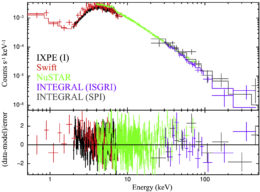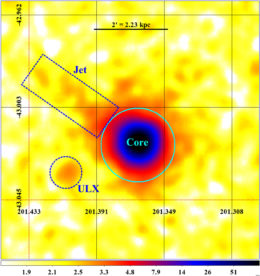Deep inside the dust-shrouded core of radio galaxy Centaurus A, particles are being accelerated to relativistic speeds. What’s causing this acceleration, and what’s the nature of the matter around this energetic core? By using multiple telescopes to observe nearly the entire X-ray spectrum, astronomers may be getting closer to unlocking the answers.

A diagram showing the concept of polarization; unpolarized light has electric fields going in all directions but polarized light has its electric field going in only one direction/vibrating in only one plane. Magnetic fields in space can change the orientation of the electric field, resulting in polarized light. [PhysicsOpenLab]
Getting to the Core of the Mystery
Polarization, or the way the electromagnetic waves are oriented, is a powerful tool in astrophysics; the same concept that allows sunglasses to reduce glare can also be used to probe the emission mechanism of magnetized neutron stars and study the orientation of magnetic fields. Measurements of the polarization properties of jets around the high-energy cores of supermassive black holes can help illuminate what type of physics is taking place, in particular how the high-energy emission is produced and how it behaves. These polarization measurements provide a valuable counterpart to other ways we probe the physics around black hole jets — like by examining how X-ray intensity varies with frequency.
Using simultaneous observations from multiple X-ray telescopes, a team led by Steven Ehlert at NASA’s Marshall Space Flight Center explores the polarization of the material and the X-ray spectrum around Centaurus A in order to better understand the material around the galaxy’s core. Centaurus A is of particular interest because it contains an active galactic nucleus — a black hole spewing radio jets into space — and it also emits X-rays. Though many studies have observed the X-ray emission from its core, we still haven’t pinpointed the source of this energetic light.
A Slew of X-Ray Telescope Observations
The team used the Imaging X-ray Polarimetry Explorer (IXPE) to observe polarized X-ray emission from Centaurus A. IXPE is a brand new mission dedicated to studying polarized X-ray emission from sources such as neutron stars and supermassive black holes. Launched in December 2021, the first science images from the mission were released this past February. The instrument measured low degrees of polarization in the core of Centaurus A, which suggests that the X-ray emission is coming from a scattering process rather than arising directly from the accelerated particles of the jet. The low degree of polarization, specifically near the core region, indicates that electrons are accelerated in an area around the core where the magnetic field lines are twisted and disordered.

The spectrum of the source taken with the various telescopes, fit with a simple power law. [Ehlert et al. 2022]
A Unique Radio Galaxy?
This work, which is consistent with previous studies at other wavelengths, shows that the X-rays coming from Centaurus A’s core are produced by particles that are accelerated within about a light-year of the central black hole. Studying other galaxies that host luminous, accreting supermassive black holes will allow scientists to understand if the low degree of X-ray polarization is common, or if Centaurus A is unique among the population.
Citation
“Limits on X-Ray Polarization at the Core of Centaurus A as Observed with the Imaging X-Ray Polarimetry Explorer,” Steven R. Ehlert et al 2022 ApJ 935 116. doi:10.3847/1538-4357/ac8056


